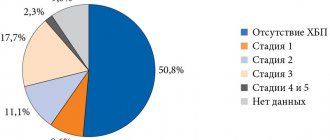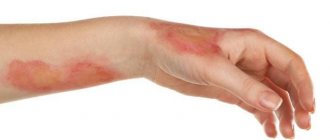Ambroxol is an effective and safe medication that is used to treat wet cough. A mucolytic is prescribed for respiratory diseases if they are accompanied by the formation of scanty or viscous sputum. The medication is approved in the neonatal period, pregnancy, in children of any age group, adults and elderly patients.
Ambroxol 30 ml 6+
For what diseases can it be used?
Ambroxol is indicated for respiratory pathologies that are accompanied by damage to the mucous membrane of the trachea and bronchi with the separation of viscous and scanty sputum. Such pathologies include:
- acute and chronic inflammation of the bronchi;
- bronchial asthma;
- pneumonia;
- bronchiectasis;
- chronic obstructive pulmonary disease.
A medication is prescribed to improve sputum discharge. You can read more about cough treatment here.
How to use the medicine?
According to the instructions for use, Ambroxol can be used orally or inhaled. For oral use there are tablet forms, solution (for oral use) and syrup. For inhalation administration there is also a separate form in the form of a solution.
Ambroxol tablets - what do they help with, how to take them?
The tablet form helps with coughs due to bronchitis, pneumonia and other diseases in which phlegm is difficult to cough up. Drinking tablet forms is recommended for patients over 6 years of age.
Dosages of the drug:
- 6 - 12 years - 15 mg twice or thrice a day;
- from 12 years of age - 30 mg three times a day.
You can take the drug regardless of meals.
If treatment does not help, patients over 12 years of age can increase the dosage to 60 mg twice daily. The tablet form should be washed down with ½-1 glass of water. The course of therapy is 5 days. If treatment does not help in the first 4-5 days, you should see a doctor to adjust your therapy.
To ensure a good effect of therapy, it is recommended to drink more water, juices and fruit drinks that do not have a diuretic effect. This promotes better discharge of bronchial secretions. You should not take the medicine before going to bed. This can lead to mucus stagnation. This recommendation especially applies to young children.
Method of using syrup
The syrup form is more often used in children. It has a pleasant taste, which makes therapy easier. The medicine should be taken orally in the following doses:
- up to 2 years of age - 2.5 ml twice a day;
- 2-6 years - 2.5 ml three times a day;
- 6-12 years - 5 ml 2-3 times a day;
- patients over 12 years of age - 10 ml three times a day for the first 3 days of therapy, then the dosage is reduced to 10 ml twice a day.
Course therapy lasts up to 5 days.
When using the drug, you should strictly follow the instructions to prevent overdose. Maximum dose per day:
- adult patients equal to 120 mg;
- 6-12 years - 45 mg;
- 2-6 years of age - 22.5 mg;
- up to 2 years of age - 15 mg.
An opened bottle should be stored for no more than 1 month.
Attention! The use of Ambroxol in children under 2 years of age should only be done under the supervision of a doctor.
Ambroxol syrup
Ambroxol for inhalation - how to use?
For inhalation administration of the drug there is a special solution with a concentration of 7.5 mg/ml. It is sold in 40 and 100 ml bottles. The drug is suitable for use in nebulizers, as it has very small molecules. Do not spray the medication using a steam inhaler.
Dosages:
- adult patients and children over 6 years of age - the inhalation procedure is carried out 1-2 times a day, 2-3 ml of medicine is required to prepare the solution;
- children under 6 years old - 1-2 inhalation procedures, 2 ml for each manipulation.
To fill the inhalation device, you need to prepare a working solution. To do this, Ambroxol solution is mixed with 0.9% sodium chloride in a 1:1 ratio. Before carrying out the manipulation, the working solution should be heated to 35-36°C to avoid hypothermia of the respiratory tract mucosa. Cold vapors provoke constriction of blood vessels in the lungs and a reflex cough.
During the inhalation procedure, the child or adult should breathe normally. Forced breathing provokes a cough reflex. Infants are recommended to do the inhalation procedure while sleeping, so as not to frighten the baby or cause crying.
If inhalations are prescribed to a patient with bronchial asthma, the manipulation is carried out after the patient has taken bronchodilators. This will help prevent reflex spasm of the bronchi and irritation of the mucous membrane.
Course therapy lasts 4-5 days. If therapy does not help, you should see a doctor for further examination and correction of therapy.
Attention! Inhalations in children under 2 years of age are carried out only under the supervision of a pediatrician or pulmonologist. The doctor must constantly evaluate the dynamics and reaction of the baby to the drug. The specialist explains to the parents the rules of the procedure and safety measures if inhalation will be carried out at home.
Ambroxol solution for inhalation
Ambrovix syrup with banana flavor 15mg/5ml 150ml bottle No. 1
International nonproprietary name: Ambroxol Dosage form: syrup 15 mg/5 ml pineapple flavor syrup 30 mg/5 ml pineapple flavor syrup 15 mg/5 ml banana flavor syrup 30 mg/5 ml banana flavor
Description of the dosage form Ambrovix, syrup with pineapple flavor: transparent, colorless or yellowish, slightly viscous liquid with a specific pineapple odor; Ambrovix, banana flavored syrup: clear, colorless or yellowish, slightly viscous liquid with a specific banana odor.
Composition: 5 ml of syrup contain as active substance 0.015 g (15 mg) or 0.03 g (30 mg) ambroxol hydrochloride Excipients: methyl parahydroxybenzoate, propyl parahydroxybenzoate, sorbitol non-crystallizing solution, propylene glycol, ethyl alcohol, concentrated hydrochloric acid, flavoring additive Aromatic Pineapple AE 111, flavoring additive Aromatic Banana AE 210, purified water. Pharmacotherapeutic group: mucolytic agent. ATX code: R05CB06.
Indications for use Secretolytic therapy for acute and chronic bronchopulmonary diseases associated with impaired bronchial secretion and weakened mucus movement.
Method of administration and dosage The drug can be taken regardless of meals. Ambrovix 15 mg/5 ml: adults and children over 12 years of age: 10 ml (2 teaspoons) 3 times a day; children 6-12 years old: 5 ml (1 teaspoon) 2-3 times a day; children aged 2-6 years: 2.5 ml (1/2 teaspoon) 3 times a day. Ambrovix 30 mg/5 ml: adults and children over 12 years of age: 10 ml (2 teaspoons) twice daily. The duration of treatment for acute respiratory diseases and initial treatment of chronic conditions is up to 14 days. You should consult your doctor if symptoms last more than 14 days and/or symptoms worsen despite taking Ambrovix. A high dose dosing regimen should be used during initial treatment, the dose may be halved after 14 days of taking the drug. In case of acute illnesses, you should consult a doctor if symptoms do not disappear and/or intensify despite taking Ambrovix syrup.
Side effects The assessment of undesirable effects is based on the following data on the frequency of occurrence: very often (>1/10), often (>1/100 to <1/10), infrequently (>1/1000 to <1/100), rarely ( >1/10,000 to <1/1000), very rare (<1/10,000), unknown (cannot be estimated from available data). From the immune system, skin and subcutaneous tissue Rarely: rash, urticaria. Not known: angioedema, pruritus, anaphylactic reactions including shock, other hypersensitivity reactions. From the nervous system: often: dysgeusia. From the gastrointestinal tract Often: nausea, numbness of the mouth. Uncommon: vomiting, diarrhea, dyspepsia, abdominal pain, dry mouth. Very rare: constipation, drooling. Unknown: dry throat. Respiratory, chest and mediastinal disorders Common: numbness in the throat. Very rare: rhinorrhea. Unknown: shortness of breath (as a symptom of a hypersensitivity reaction). From the kidneys and urinary tract Very rarely: dysuria. Other Uncommon: fever, skin and mucous membrane reactions.
Contraindications Hypersensitivity to the components of the drug; - children under 2 years old; pregnancy (first trimester); lactation period.
Overdose Symptoms: nausea, vomiting, diarrhea, dyspeptic disorders, drop in blood pressure. Treatment: Artificial vomiting, gastric lavage (in the first 1-2 hours after taking the drug); intake of fat-containing foods. If necessary, carry out symptomatic therapy.
Interactions with other drugs Ambrovix is not prescribed simultaneously with antitussives (for example, those containing codeine), as this makes it difficult to clear liquefied sputum from the bronchi while suppressing the cough reflex. Ambroxol promotes the penetration of antibiotics (amoxicillin, cefuroxime, oxytetracycline, doxycycline, erythromycin) into bronchial secretions.
Precautions In extremely weakened patients, patients with anatomical narrowing of the bronchi and increased mucus secretion, when using ambroxol, difficulties may arise in the evacuation of bronchial secretions. In these cases, measures should be taken to suck out the secretions. The drug should be prescribed with caution for peptic ulcers of the stomach and duodenum. For patients with diabetes mellitus, the content of sorbitol solution in the syrup should be 70%. If you miss taking the drug, you should not double the dose. In case of severe renal and liver dysfunction, lower concentrations should be used or the interval between doses of the drug should be increased. Several cases of severe skin damage have been reported, including Stevens-Johnson syndrome and toxic epidermal necrolysis, associated with expectorants such as ambroxol. This condition can usually be explained by the severity of the concomitant disease or the simultaneous use of other drugs. In addition, in the early stages of Stevens-Johnson syndrome and toxic epidermal necrolysis, patients may exhibit nonspecific signs of the onset of a flu-like illness: fever, body pain, rhinitis, cough, and sore throat. The appearance of these signs may lead to unnecessary symptomatic treatment with cold medications. Therefore, if damage to the skin or mucous membranes occurs, you should immediately consult a doctor, and treatment with ambroxol should be discontinued as a precaution.
Pregnancy and lactation It is possible to use it in the second and third trimester of pregnancy if the expected effect of therapy exceeds the potential risk to the fetus. Breastfeeding should be stopped during treatment.
Effect on the ability to drive a car or other moving mechanisms. There are no known cases of the drug affecting the ability to drive a car or use machinery. No relevant studies have been conducted.
Release form and packaging 100 ml and 150 ml of syrup in bottles, placed together with the package insert in cardboard packs.
Storage conditions Store in a place protected from light at a temperature not exceeding 25C. Keep out of the reach of children.
Shelf life: 2 years. The expiration date is indicated on the packaging. This medicine should not be used after the date stated on the package. Shelf life after opening the bottle is 6 months.
Conditions for dispensing from pharmacies The drug is dispensed without a doctor's prescription.
Special conditions
The medication should not be used together with antitussives. This will lead to stagnation of mucus in the bronchial cavity due to suppression of the cough reflex. It is not advisable to prescribe the medicine to patients whose cough reflex is weak.
You should not perform breathing exercises while taking the medication. Exercise worsens the flow of bronchial secretions. If the patient is in serious condition, the sputum must be sucked out with an aspirator.
Attention! You should not take the medication before going to bed. This can lead to stagnation of bronchial mucus and obstruction of the airways due to the extinction of the cough reflex during rest.
In bronchial asthma, the drug provokes an increase in the cough reflex. If the patient has skin lesions (Stevens-Johnson syndrome or toxic epidermal necrolysis), at the onset of the disease a flu-like condition may appear (body aches, pyrexia, runny nose, cough, sore throat. With such symptoms, the use of Ambroxol may be wrong.
For patients with kidney pathologies, the medicine should be prescribed by a doctor. If the medication is prescribed to a patient with diabetes, it is necessary to take into account the glucose that is present in the drug as an auxiliary component.
Ambroxol Renewal 20 tablets. 30 mg
Azt Long and Ambroxol: which is better
ACC is based on the substance acetylcysteine, which, like Ambroxol, improves the rheological properties of sputum: it accelerates its production, reducing viscosity. The ciliated epithelium of the respiratory tract instantly reacts to the irritant, provoking a cough. A drug with the prefix “Long” indicates that the effect of a single dose is prolonged up to 12 hours. This means you need to take it in the morning, once a day. Taking Azz Long at night will cause the patient to have a cough that will suffocate him all night, preventing him from falling asleep.
When choosing between ACC and Ambroxol, you need to rely on the convenience of the release form for the patient and individual intolerance to the components.
When prohibited
The medicine is not indicated for allergies to its components. The drug is prohibited for:
- gestation in the first 3 months;
- feeding the baby;
- aged less than 6 years (tablets);
- under 12 years of age (long-acting tablets).
The medicine is carefully used in case of disruption of the mucous membrane of the bronchial tree, pathology of the kidneys and liver. Prescribed with caution for ulcerative defects of the digestive tract, pregnancy (2nd and 3rd trimester), and patients under 2 years of age.
Similar medications
The drug has structural and non-structural analogues. Structural forms include those dosage forms that are similar in composition. Non-structural analogues differ in their active components. Structural analogues:
- Ambrobene,
- Thoraxol,
- Halixol,
- Ambroxol extra (tablets),
- Lazolvan.
All these medications have the same components and forms.
Non-structural analogues include :
- Bromhexine - contains bromhexine hydrochloride, the forms of the drug are the same.
- Mucaltin - based on marshmallow herb, gently removes phlegm, less effective.
- ACC - contains acetylcysteine, is produced in the form of syrup, granules, solution, effervescent tablets, powder.
- Bronchipret - based on medicinal herbs (thyme and ivy), available in the form of syrup and drops.
- Tussin - contains guaifenesin, which thins bronchial mucus, and is sold in the form of syrup.
The choice of drug is made by the doctor.
Ambrobene, 7.5 mg/ml, solution for oral administration and inhalation, 100 ml, 1 pc.
Teva, Germany
Price from 142₽
Lazolvan, 7.5 mg/ml, solution for oral administration and inhalation, 100 ml, 1 pc.
Boehringer Ingelheim, Italy
Price from 311₽
Bronchipret, syrup, 100 ml, 1 pc.
Bionorica, Germany
Price from 300₽
There are contraindications. Specialist consultation is required.
Ambroxol or Bromhexine - which is better?
Ambroxol and Bromhexine are very similar in their therapeutic effects. Bromhexine contains bromhexine hydrochloride, which is metabolized into ambroxol. Ambroxol contains ambroxol hydrochloride.
When using Bromhexine, the effectiveness of treatment will be weaker. This is due to the time required to convert bromhexine hydrochloride to ambroxol.
When treated with Ambroxol, the effect of treatment is stronger, since the active substance enters the body in the required form. You cannot take medications at the same time. Overdose is possible.
Ambroxol is an effective remedy for wet cough with scanty sputum. It is actively used in adult and pediatric practice. The medication has a small number of contraindications and rarely causes complications. It is safe even for pregnant women in the 2nd and 3rd trimester. Despite the free sale in pharmacies, it is advisable to use the medication as prescribed by a doctor.
What is ambroxol hydrochloride
Ambroxol hydrochloride is a substance that directly affects the secretory function of the respiratory tract, causing the glands to work more actively, which leads to increased production of sputum. In addition, Ambroxol directly affects the motor function of the trachea and bronchi, which explains the expectorant effect. The tissues of the upper and lower respiratory tract are instantly irritated at the slightest fluctuations in the ciliated epithelium, causing a cough that easily expels liquid sputum along with the pathogen.








